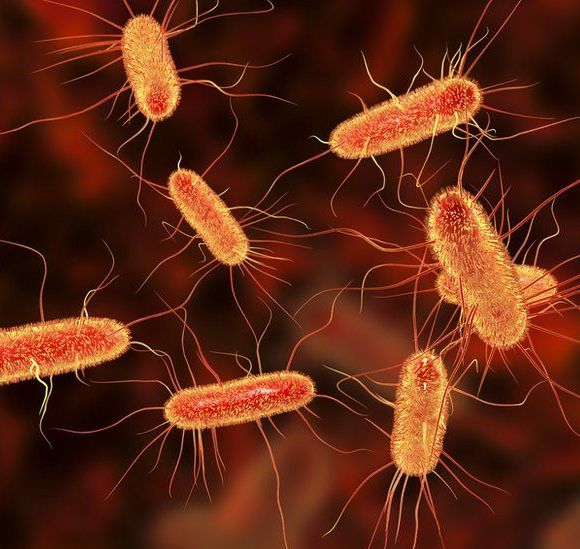E. coli (Escherichia coli)

UPDATE August 20, 2021: CDC and FDA are investigating a current E. coli outbreak linked to boxed cake mixes. See "Current/Recent Outbreaks" section below for more information.
Escherichia coli (E. coli) is a bacterium present in the gastrointestinal tracts of both people and animals.
There are two factors to consider regarding E. coli during pregnancy: E. coli infection due to foodborne illness, and infection passed to the newborn due to E. coli present in the genital tract near delivery. Both sources of infection can potentially cause fetal and newborn infection.
Foodborne E. coli infection can be prevented with proper hygiene practices and food safety preparation, as well as through the avoidance of certain “higher risk” activities (petting zoos, county fairs).
E. coli genital tract infection cannot be prevented in most cases; women usually have no symptoms if E. coli is present in the genital tract, and screening for this bacterium is not standard procedure in obstetrics in the way group B streptococcus is screened.
However, health care providers (HCP) may screen for urinary tract infections at least once during pregnancy. E. coli of the genital tract causes most UTIs during pregnancy, which need to be treated immediately. Women should continue reading for more information.
Background
Escherichia coli (E. coli) are a large group of bacteria found in the environment, foods, and intestines of people and animals.
There are many strains of E. coli, most of which do not make individuals sick. However, other strains of E. coli can cause three different types of illnesses: gastrointestinal, urinary tract infections, and neonatal meningitis.
The most common strain is Shiga toxin-producing E. coli (STEC), that causes an estimated 265,000 infections each year in the United States. STEC is usually caused by getting microscopic amounts of the bacteria in the body via the mouth; STEC most often causes diarrhea.
The most severe type of E. coli is O157:H7 (VTEC); VTEC causes bloody diarrhea that may lead to kidney failure and even death. This strain (and STEC) has been linked to hemolytic uremic syndrome, an infection that destroys red blood cells.
Cause/Sources
Foodborne exposure can result from eating contaminated food (raw vegetables, undercooked beef), unpasteurized (raw) milk, contaminated water, or contact with cattle or feces of infected people or animals.
Specific sources of contamination can include:
Private wells with no disinfecting system
Swimming in pools or lakes contaminated with feces
Petting zoos (cows, sheep, goats)
County fairs
Uncooked ground beef
Unwashed produce
Unpasteurized dairy products (milk, cheese)
Inadequate hand washing (such as after using the bathroom)
Most E. coli infections in the U.S. occur from June through September; the reasons for this are not clear, but possibly due to more grilling, swimming in pools and lakes, and visiting county fairs and petting zoos.

Symptoms and Complications – General
Symptoms can begin as soon as 20 minutes after consumption of a contaminated food; on average, symptoms appear within 1 to 3 days, but in some cases as long as 6 weeks later. Most individuals can recover without treatment (hydration may be necessary) in about 5 to 7 days.
The symptoms of STEC infections vary but include low-grade fever, severe stomach cramps, diarrhea (often bloody), and vomiting. While most infections are mild, E. coli infection can be life-threatening in some cases.
People who have weakened immune systems from underlying conditions are more likely to develop more serious E. coli infection (pregnant women do not have "weakened" immune systems; read more here).
However, pregnant women who regularly take proton pump inhibitors, which is common, may have more severe illness based on reduced stomach acid levels that may be less effective at killing the bacteria.
Pregnancy
Pregnancy-related outcomes of E. coli infection are highly dependent on the type and severity of infection, as well as timing of treatment.
E. coli infection, when severe, is specifically linked to a higher risk of miscarriage, preterm rupture of membranes, preterm delivery, and stillbirth. E. coli infection during pregnancy has not been associated with a higher chance of birth defects.
E. coli may also be of concern during delivery, even when not contracted through food/animal contact.
All humans carry E. coli in the genital tract. High colonization of this bacteria (3% to 20% of pregnant women), even if the mother is not sick, can pass to the fetus during delivery, causing infection in the newborn which can be fatal (bacteremia). E. coli has also been identified in amniotic fluid which the fetus swallows. Colonization occurs most often in the third trimester – similar to group B strep.

Group B streptococcus (group B strep) and E. coli are the leading causes of early-onset neonatal sepsis (bacteria enters bloodstream). Currently, only group B strep is routinely screened for in pregnant women.
The incidence of neonatal E. coli infection is estimated to be between 0.2 and 5 per 1,000 live births, and usually occurs from infection during vaginal delivery; only a few strains are assessed to be virulent enough to cause neonatal infection. For comparison, group B strep neonatal infection occurs in an estimated 0.34 to 0.37 per 1,000 live births (routine screening).
At least one study noted one-third of the pregnant participants were colonized with E. coli in the rectovaginal region, which indicated their babies were at risk of infection during or before vaginal delivery if the E. coli were to invade the fetal membranes or amniotic fluid.
However, little is known about the prevalence of E. coli colonization in pregnant women and and its resulting neonatal outcomes. It is possible that programs to screen for vaginal colonization by E. coli may be useful in some "at risk" pregnant women, especially those with recurrent Urinary Tract Infections (UTI).
Women should also consider sharing and submitting their experience below regarding E. coli during pregnancy. This can help women hear from other women who have been through this same condition and concern.
Urinary Tract Infection
E. coli is the most common organism that causes UTIs, accounting for 80% to 90% of all infections. Group B strep follows behind at around 5% of infections.
UTI in pregnancy is associated with significant complications for both mother and baby; almost all women are screened for UTIs during at least the first trimester (urine test). Most women who screen positive for UTI have no symptoms.
According to at least one study, the most common obstetric reason for hospitalization with an untreated UTI due to E. coli was threatened preterm labor, fever, and threatened pregnancy loss.
Untreated UTIs are also associated with fetal growth restriction, low birth weight, maternal high blood pressure, preeclampsia, and anemia. Sepsis can occur in both mother and baby. Early treatment with antibiotics has significantly reduced these complications.
Read more about Urinary Tract Infections during pregnancy, to include signs and symptoms of possible infection.
Management
If a pregnant woman presents to her HCP with diarrhea, and the HCP suspects E. coli foodborne infection, a stool sample may be requested and sent to a lab for testing to determine the strain/toxins.
Treatment is usually supportive, which includes rest and fluids (water and electrolytes). Antibiotics are not used for mild E. coli infections due to growing antibiotic resistance.
Antibiotics may be used, however, in severe cases, especially to prevent spread of infection to the bloodstream and fetus, including UTIs. An infected neonate may also require antibiotics.
Most healthy adults recover from E. coli illness within a week, but pregnant women can have a more difficult time not only recovering, but managing their symptoms.
However, pregnant women experiencing diarrhea need to call their HCP prior to taking any over-the-counter medication, which could worsen their infection.
Action
If a pregnant woman suspects she may have a foodborne illness, she needs to contact her HCP, or visit an emergency room if symptoms are severe.
In general, women should contact their HCP if they are experiencing diarrhea that lasts for more than three days, or diarrhea is accompanied by high fever, blood in the stool, or vomiting. Women should also see their HCP if they cannot keep fluids down.
Raw sprouts are a relatively common produce item that carry a higher risk for E. coli infection. It is advised that pregnant women avoid raw sprouts all together, to include in sandwiches and salads. Pregnant women should also avoid raw cookie dough, unpasteurized (raw) milk, unpasteurized apple cider, and soft cheeses made from raw milk. Read more.

Women should also avoid swallowing water when swimming or playing in lakes, ponds, streams, swimming pools, and backyard “kiddie” pools, when possible. When visiting county fairs or farms in which contact with animals was made, women should immediately and thoroughly wash their hands.
Women should always practice good food safety habits when grocery shopping, cooking (especially ground beef), cleaning, storing, and eating out. Read more.
Current/Recent Outbreaks
As of July 28, 2021, CDC and FDA are investigating an E. coli outbreak linked to boxed cake mixes. Sick people in this outbreak reported tasting or eating raw cake batter made from a variety of cake mixes. A single brand or type of cake mix has not been linked to the illnesses. To date, this outbreak has been linked to 16 illnesses and 7 hospitalizations.
According to CDC:
Do not taste or eat any raw batter, whether it is from a homemade recipe or from a mix.
Do not let children eat raw batter. Foodborne illnesses can be more serious for children.
Bake or cook raw batter before eating.
Follow the recipe or package directions for cooking or baking at the proper temperature and for the specified time.
Do not make milkshakes with products that contain raw foods such as cake mix, flour, or eggs.
Keep raw foods such as cake mix, flour, or eggs separate from ready-to-eat foods. Because cake mix and flour are powders, they can spread easily.
Follow label directions to refrigerate products containing raw batter or eggs until they are cooked.
Clean up thoroughly after handling cake mix, flour, or eggs:
Wash your hands with running water and soap after handling cake mix, flour, raw eggs, or any surfaces they have touched.
Wash bowls, utensils, countertops, and other surfaces with warm, soapy water.

Partners/Support
Partners and family members of pregnant women should follow the same guidelines above for the prevention of E. coli infection. Any individual who cooks or prepares food should learn proper food safety and best practices to avoid foodborne illness – for the entire family.
Resources
Focus on Ground Beef (U.S. Department of Agriculture)
E. coli Fact Sheet (U.S. Centers for Disease Control and Prevention)
E. coli (Escherichia coli) (U.S. Centers for Disease Control and Prevention)
Escherichia coli (E. coli) (MotherToBaby.org)
E. coli and Food Safety (U.S. Centers for Disease Control and Prevention)
FDA Continues to Warn Against Eating Raw Dough for Cookies or Other Raw Dough Products Before Cooking (U.S. Food and Drug Administration)
E. coli Outbreak and Raw Cookie Dough (U.S. Centers for Disease Control and Prevention)
Prevent Infections During Pregnancy (U.S. Centers for Disease Control and Prevention)